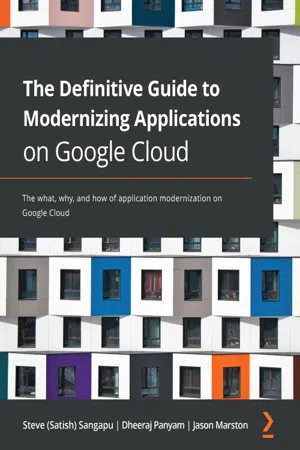
The Definitive Guide to Modernizing Applications on Google Cloud
- 488 pages
- English
- ePUB (mobile friendly)
- Available on iOS & Android
The Definitive Guide to Modernizing Applications on Google Cloud
About This Book
Get to grips with the tools, services, and functions needed for application migration to help you move from legacy applications to cloud-native on Google CloudKey Features• Discover how a sample legacy application can be transformed into a cloud-native application on Google Cloud• Learn where to start and how to apply application modernization techniques and tooling• Work with real-world use cases and instructions to modernize an application on Google CloudBook DescriptionLegacy applications, which comprise 75–80% of all enterprise applications, often end up being stuck in data centers. Modernizing these applications to make them cloud-native enables them to scale in a cloud environment without taking months or years to start seeing the benefits. This book will help software developers and solutions architects to modernize their applications on Google Cloud and transform them into cloud-native applications.This book helps you to build on your existing knowledge of enterprise application development and takes you on a journey through the six Rs: rehosting, replatforming, rearchitecting, repurchasing, retiring, and retaining. You'll learn how to modernize a legacy enterprise application on Google Cloud and build on existing assets and skills effectively. Taking an iterative and incremental approach to modernization, the book introduces the main services in Google Cloud in an easy-to-understand way that can be applied immediately to an application.By the end of this Google Cloud book, you'll have learned how to modernize a legacy enterprise application by exploring various interim architectures and tooling to develop a cloud-native microservices-based application.What you will learn• Discover the principles and best practices for building cloud-native applications• Study the six Rs of migration strategy and learn when to choose which strategy• Rehost a legacy enterprise application on Google Compute Engine• Replatform an application to use Google Load Balancer and Google Cloud SQL• Refactor into a single-page application (SPA) supported by REST services• Replatform an application to use Google Identity Platform and Firebase Authentication• Refactor to microservices using the strangler pattern• Automate the deployment process using a CI/CD pipeline with Google Cloud BuildWho this book is forThis book is for software developers and solutions architects looking to gain experience in modernizing their enterprise applications to run on Google Cloud and transform them into cloud-native applications. Basic knowledge of Java and Spring Boot is necessary. Prior knowledge of Google Cloud is useful but not mandatory.
Frequently asked questions
Information
Section 1: Cloud-Native Application Development and App Modernization in Google Cloud
- Chapter 1, Cloud-Native Application Fundamentals
- Chapter 2, End-to-End Extensible Tooling for Cloud-Native Application Development
- Chapter 3, Cloud-Native Architecture Patterns and System Architecture Tenets
Chapter 1: Cloud-Native Application Fundamentals
- The cloud-native ecosystem
- Benefits of cloud-native architecture
- Principles of cloud-native architecture
- Applying the 12-factor app principles on Google Cloud
The cloud-native ecosystem
- Scalability, a defining characteristic.
- The pay-per-use model makes the applications cost-effective.
- Managed services that make cloud-native applications not only versatile but also very developer-friendly.
- Managed: Use the cloud platform as an infrastructure (be dependent on it to do all the computing).
- Scalable: Quickly increase or decrease resources to match the demand.
- Resilient: A single bug or crash should not take down the application.
- Loosely coupled: Parts of the application should be isolated enough for them to be altered or removed without any downtime.
Benefits of cloud-native applications
Increased speed of delivery
Not monolithic
Independent development of microservices
Independent deployment of microservices
Increased scalability
Table of contents
- The Definitive Guide to Modernizing Applications on Google Cloud
- Contributors
- Preface
- Section 1: Cloud-Native Application Development and App Modernization in Google Cloud
- Chapter 1: Cloud-Native Application Fundamentals
- Chapter 2: End-to-End Extensible Tooling for Cloud-Native Application Development
- Chapter 3: Cloud-Native Architecture Patterns and System Architecture Tenets
- Section 2: Selecting the Right Google Cloud Services
- Chapter 4: Choosing the Right Compute Option
- Chapter 5: Choosing the Right Database and Storage
- Chapter 6: Implementing a Messaging and Scheduling System
- Chapter 7: Implementing Cloud-Native Security
- Section 3: Rehosting and Replatforming the Application
- Chapter 8: Introducing the Legacy Application
- Chapter 9: The Initial Architecture on Google Compute Engine
- Chapter 10: Addressing Scalability and Availability
- Chapter 11: Re-Platforming the Data Layer
- Chapter 12: Designing the Interim Architecture
- Chapter 13: Refactoring to Microservices
- Section 4: Refactoring the Application on Cloud-Native/PaaS and Serverless in Google Cloud
- Chapter 14: Refactoring the Frontend and Exposing REST Services
- Chapter 15: Handling Eventual Consistency with the Compensation Pattern
- Chapter 16: Orchestrating Your Application with Google Kubernetes Engine
- Chapter 17: Going Serverless with Google App Engine
- Chapter 18: Future Proofing Your App with Google Cloud Run
- Appendix A: Choosing the Right Migration Strategy
- Appendix B: Application Modernization Solutions
- Other Books You May Enjoy